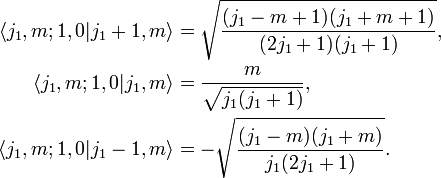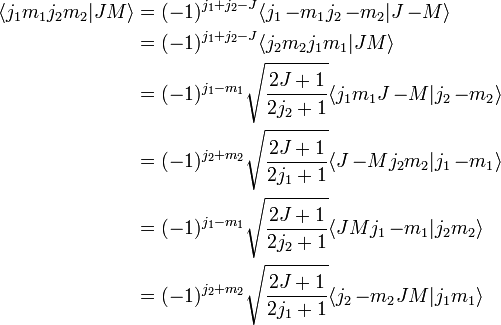Clebsch–Gordan coefficients
In physics, the Clebsch–Gordan coefficients are sets of numbers that arise in angular momentum coupling under the laws of quantum mechanics.
In more mathematical terms, the CG coefficients are used in representation theory, particularly of compact Lie groups, to perform the explicit direct sum decomposition of the tensor product of two irreducible representations into irreducible representations, in cases where the numbers and types of irreducible components are already known abstractly. The name derives from the German mathematicians Alfred Clebsch (1833–1872) and Paul Gordan (1837–1912), who encountered an equivalent problem in invariant theory.
In terms of classical mathematics, the CG coefficients, or at least those associated to the group SO(3), may be defined much more directly, by means of formulae for the multiplication of spherical harmonics. The addition of spins in quantum-mechanical terms can be read directly from this approach. The formulas below use Dirac's bra-ket notation.
Clebsch–Gordan coefficients are the expansion coefficients of total angular momentum eigenstates in an uncoupled tensor product basis.
Below, this definition is made precise by defining angular momentum operators, angular momentum eigenstates, and tensor products of these states.
From the formal definition of angular momentum, recursion relations for the Clebsch–Gordan coefficients can be found. To find numerical values for the coefficients a phase convention must be adopted. Below the Condon–Shortley phase convention is chosen.
Angular momentum operators
Angular momentum operators are self-adjoint operators  ,
,  ,
and
,
and  that satisfy the commutation relations
that satisfy the commutation relations
where  is the Levi-Civita symbol. Together the three operators define a "vector operator":
is the Levi-Civita symbol. Together the three operators define a "vector operator":

By developing this concept further, one can define an operator as an "inner product" of  with itself:
with itself:
It is an example of a Casimir operator.
We also define raising ( ) and lowering (
) and lowering ( ) operators:
) operators:
Angular momentum states
It can be shown from the above definitions that  commutes with
commutes with  ,
,  and
and 
When two Hermitian operators commute, a common set of eigenfunctions exists.
Conventionally  and
and  are chosen.
From the commutation relations the possible eigenvalues can be found.
The result is:
are chosen.
From the commutation relations the possible eigenvalues can be found.
The result is:
The raising and lowering operators change the value of  :
:
with
A (complex) phase factor could be included in the definition of  .
The choice made here is in agreement with the Condon and Shortley phase conventions.
The angular momentum states must be orthogonal (because their eigenvalues with
respect to a Hermitian operator are distinct) and are assumed to be normalized:
.
The choice made here is in agreement with the Condon and Shortley phase conventions.
The angular momentum states must be orthogonal (because their eigenvalues with
respect to a Hermitian operator are distinct) and are assumed to be normalized:
Note that the italicized  and
and  denote integers or half-integers, which label the total angular momentum of the system (e.g.
denote integers or half-integers, which label the total angular momentum of the system (e.g.  for an electron and
for an electron and  for a photon). On the other hand, the roman
for a photon). On the other hand, the roman  and
and  denote operators (the last being a vector operator).
denote operators (the last being a vector operator).
Tensor product space
Let  be the
be the  -dimensional
vector space spanned by the states
-dimensional
vector space spanned by the states
and  the
the  -dimensional vector space spanned by
-dimensional vector space spanned by
The tensor product of these spaces,  ,
has a
,
has a  -dimensional uncoupled basis
-dimensional uncoupled basis
Angular momentum operators acting on  can be defined by
can be defined by
and
Total angular momentum operators are defined by
The total angular momentum operators satisfy the required commutation relations
and hence total angular momentum eigenstates exist:
It can be derived that the total angular momentum quantum number  must satisfy the triangular condition
must satisfy the triangular condition
The total number of total angular momentum eigenstates is equal to the dimension of  :
:
The total angular momentum states form an orthonormal basis of  :
:
Formal definition of Clebsch–Gordan coefficients
The total angular momentum states can be expanded with the use of the completeness relation in the uncoupled basis
The expansion coefficients  are called Clebsch–Gordan coefficients.
are called Clebsch–Gordan coefficients.
Applying the operator
to both sides of the defining equation shows that the Clebsch–Gordan coefficients can only be nonzero when
Recursion relations
The recursion relations were discovered by physicist Giulio Racah from the Hebrew University of Jerusalem in 1941.
Applying the total angular momentum raising and lowering operators
to the left hand side of the defining equation gives
Applying the same operators to the right hand side gives
where
Combining these results gives recursion relations for the Clebsch–Gordan coefficients
Taking the upper sign with  gives
gives
In the Condon and Shortley phase convention the coefficient
 is taken
real and positive. With the last equation all other
Clebsch–Gordan coefficients
is taken
real and positive. With the last equation all other
Clebsch–Gordan coefficients  can be found. The normalization is fixed by the requirement that
the sum of the squares, which corresponds to the norm of the
state
can be found. The normalization is fixed by the requirement that
the sum of the squares, which corresponds to the norm of the
state  must be one.
must be one.
The lower sign in the recursion relation can be used to find
all the Clebsch–Gordan coefficients with  .
Repeated use of that equation gives all coefficients.
.
Repeated use of that equation gives all coefficients.
This procedure to find the Clebsch–Gordan coefficients shows that they are all real (in the Condon and Shortley phase convention).
Explicit expression
For an explicit expression of the Clebsch–Gordan coefficients and tables with numerical values, see table of Clebsch–Gordan coefficients.
Orthogonality relations
These are most clearly written down by introducing the alternative notation
The first orthogonality relation is
(using the completeness relation that  )and the second
)and the second
Special cases
For  the Clebsch–Gordan coefficients are given by
the Clebsch–Gordan coefficients are given by
For  and
and  we have
we have
For  and
and  we have
we have
For  we have
we have
For  we have
we have
Symmetry properties
A convenient way to derive these relations is by converting
the Clebsch–Gordan coefficients to 3-jm symbols using the equation
given below. The symmetry properties of 3-jm symbols are much simpler.
Care is needed when simplifying phase factors, because the
quantum numbers can be integer or half integer, e.g.,  is equal to 1 for integer
is equal to 1 for integer  and
equal to −1 for half-integer
and
equal to −1 for half-integer  . The
following relations, however, are valid in either case:
. The
following relations, however, are valid in either case:
and for  ,
,  and
and  appearing in the
same Clebsch–Gordan coefficient:
appearing in the
same Clebsch–Gordan coefficient:
Relation to 3-jm symbols
Clebsch–Gordan coefficients are related to 3-jm symbols which have more convenient symmetry relations.
Relation to Wigner D-matrices
Other Properties
SU(N) Clebsch–Gordan coefficients
For arbitrary groups and their representations, Clebsch–Gordan coefficients are not known in general. However, algorithms to produce Clebsch–Gordan coefficients for the Special unitary group are known.[1] [2] A web interface for tabulating SU(N) Clebsch–Gordan coefficients is readily available.
See also
- 3-jm symbol
- Racah W-coefficient
- 6-j symbol
- 9-j symbol
- Spherical harmonics
- Spherical basis
- Associated Legendre polynomials
- Angular momentum
- Angular momentum coupling
- Total angular momentum quantum number
- Azimuthal quantum number
- Table of Clebsch–Gordan coefficients
- Wigner D-matrix
- Angular momentum diagrams (quantum mechanics)
References
- ↑ Alex, A.; M. Kalus, A. Huckleberry, and J. von Delft (February 2011). "A numerical algorithm for the explicit calculation of SU(N) and SL(N,C) Clebsch–Gordan coefficients". J. Math. Phys. 82: 023507. arXiv:1009.0437. Bibcode:2011JMP....52b3507A. doi:10.1063/1.3521562.
- ↑ Kaplan, L. M.; Resnikoff, M. (1967). "Matrix products and explicit 3, 6, 9, and 12j coefficients of the regular representation of SU(n)". J. Math. Phys. 8: 2194. doi:10.1063/1.1705141.
External links
- PDF Table of Clebsch–Gordan Coefficients, Spherical Harmonics, and d-Functions
- Clebsch–Gordan, 3-j and 6-j Coefficient Web Calculator
- Downloadable Clebsch–Gordan Coefficient Calculator for Mac and Windows
- Web interface for tabulating SU(N) Clebsch–Gordan coefficients
Further reading
- Quantum mechanics, E. Zaarur, Y. Peleg, R. Pnini, Schaum’s Easy Oulines Crash Course, Mc Graw Hill (USA), 2006, ISBN (10-)007-145533-7 ISBN (13-)978-007-145533-6
- Quantum Physics of Atoms, Molecules, Solids, Nuclei, and Particles (2nd Edition), R. Eisberg, R. Resnick, John Wiley & Sons, 1985, ISBN 978-0-471-87373-0
- Quantum Mechanics, E. Abers, Pearson Ed., Addison Wesley, Prentice Hall Inc, 2004, ISBN 978-0-13-146100-0
- Physics of Atoms and Molecules, B.H. Bransden, C.J.Joachain, Longman, 1983, ISBN 0-582-44401-2
- The Cambridge Handbook of Physics Formulas, G. Woan, Cambridge University Press, 2010, ISBN 978-0-521-57507-2.
- Encyclopaedia of Physics (2nd Edition), R.G. Lerner, G.L. Trigg, VHC publishers, 1991, ISBN (Verlagsgesellschaft) 3-527-26954-1, ISBN (VHC Inc.) 0-89573-752-3
- McGraw Hill Encyclopaedia of Physics (2nd Edition), C.B. Parker, 1994, ISBN 0-07-051400-3
- Biedenharn, L. C.; Louck, J. D. (1981). Angular Momentum in Quantum Physics. Reading, Massachusetts: Addison-Wesley. ISBN 0-201-13507-8.
- Brink, D. M.; Satchler, G. R. (1993). "Ch. 2". Angular Momentum (3rd ed.). Oxford: Clarendon Press. ISBN 0-19-851759-9.
- Condon, Edward U.; Shortley, G. H. (1970). "Ch. 3". The Theory of Atomic Spectra. Cambridge: Cambridge University Press. ISBN 0-521-09209-4.
- Edmonds, A. R. (1957). Angular Momentum in Quantum Mechanics. Princeton, New Jersey: Princeton University Press. ISBN 0-691-07912-9.
- Messiah, Albert (1981). "Ch. XIII". Quantum Mechanics (Volume II). New York: North Holland Publishing. ISBN 0-7204-0045-7.
- Zare, Richard N. (1988). "Ch. 2". Angular Momentum. New York: John Wiley & Sons. ISBN 0-471-85892-7.
| |||||||||||||||||||||||||||||||||
![[{\mathrm {j}}_{k},{\mathrm {j}}_{l}]\equiv {\mathrm {j}}_{k}{\mathrm {j}}_{l}-{\mathrm {j}}_{l}{\mathrm {j}}_{k}=i\hbar \sum _{m}\varepsilon _{{klm}}{\mathrm {j}}_{m},\quad {\mathrm {where}}\quad k,l,m\in (x,y,z)](/2014-wikipedia_en_all_02_2014/I/media/3/a/1/b/3a1b87ef5f1dcd48322480985ec54dfd.png)


![[{\mathbf {j}}^{2},{\mathrm {j}}_{k}]=0\ {\mathrm {for}}\ k=x,y,z](/2014-wikipedia_en_all_02_2014/I/media/9/e/9/2/9e924c7b93a09143a5d272fbb1f38c54.png)










![[{\mathrm {J}}_{k},{\mathrm {J}}_{l}]=i\hbar \epsilon _{{klm}}{\mathrm {J}}_{m},\quad {\mathrm {where}}\quad k,l,m\in (x,y,z),](/2014-wikipedia_en_all_02_2014/I/media/0/3/f/e/03feb38b7df640e3f2bb3dba5959e805.png)









![{\begin{aligned}{\mathrm {J}}_{\pm }&\sum _{{m_{1}m_{2}}}|j_{1}m_{1}\rangle |j_{2}m_{2}\rangle \langle j_{1}m_{1}j_{2}m_{2}|JM\rangle \\&=\hbar \sum _{{m_{1}m_{2}}}\left[C_{\pm }(j_{1},m_{1})|j_{1}m_{1}\pm 1\rangle |j_{2}m_{2}\rangle +C_{\pm }(j_{2},m_{2})|j_{1}m_{1}\rangle |j_{2}m_{2}\pm 1\rangle \right]\langle j_{1}m_{1}j_{2}m_{2}|JM\rangle \\&=\hbar \sum _{{m_{1}m_{2}}}|j_{1}m_{1}\rangle |j_{2}m_{2}\rangle \left[C_{\pm }(j_{1},m_{1}\mp 1)\langle j_{1}{m_{1}\mp 1}j_{2}m_{2}|JM\rangle +C_{\pm }(j_{2},m_{2}\mp 1)\langle j_{1}m_{1}j_{2}{m_{2}\mp 1}|JM\rangle \right].\end{aligned}}](/2014-wikipedia_en_all_02_2014/I/media/3/c/1/b/3c1ba63f85ff4fc927b98b7e4b15747e.png)
















